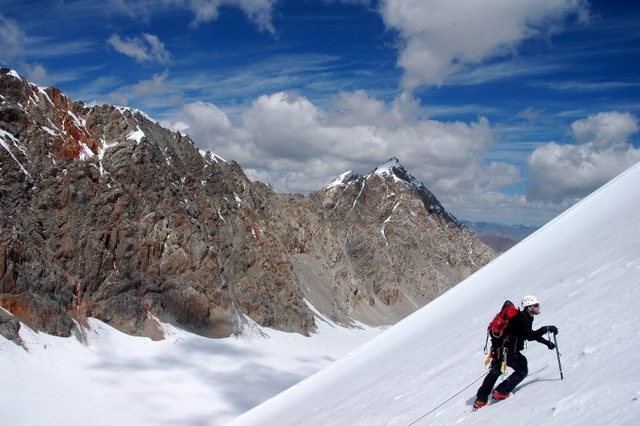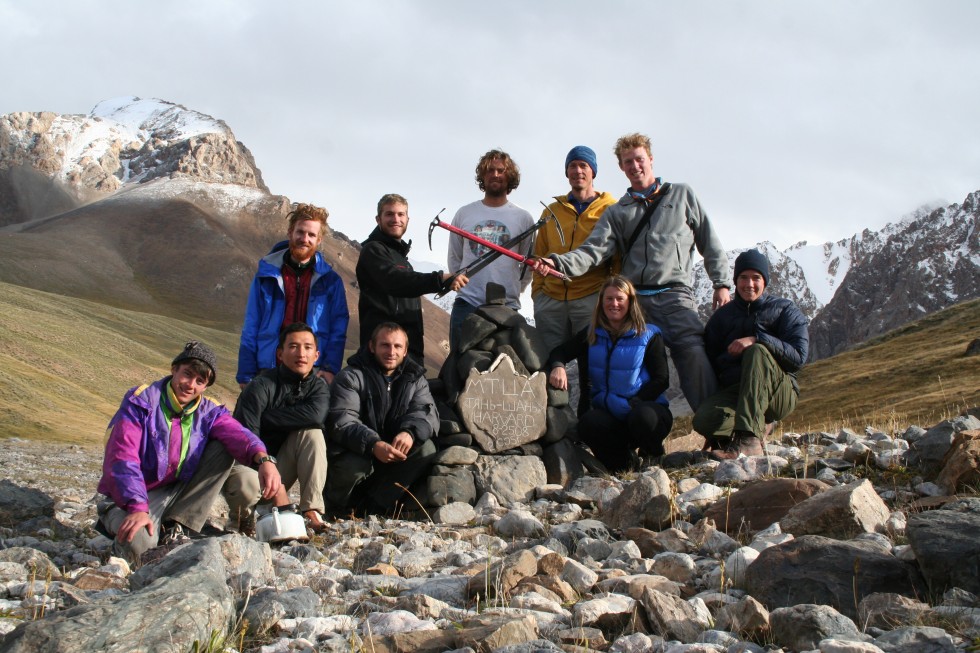It was the watermelons that finally did it. The suspicious border guard accepted the proffered bags of beer, cigarettes, and watermelons and agreed to negotiate with his supervisor at the Karasai military outpost one last time.
When he came out all smiles, we knew we were going to be allowed into the Borkoldoy mountains in the greater Tien Shan range.
The little-known range is so close to the fledgling Kyrgyz Republic’s border with China that they maintain a lonely outpost at its foot to monitor Chinese military activity. Apparently they also keep close tabs on collegiate mountaineering expeditions like ours.
I was in the company of seven other members of the Harvard Mountaineering Club, which has been at times over its eighty years the “most ambitious collection of undergraduate alpinists in the country” and at others times little more than a ragtag handful of novice wannabes.
We were somewhere in between.
At the club, I met a determined Swedish-American psychology researcher from the medical school and a second-generation Kazakh physicist bent on winning glory in the mountains. Together with a few others, we decided to chase down the dwindling dream of exploring unclimbed mountains in Kyrgyzstan.
Once past Karasai, our driver, Vitaly, followed the westward tracks left in the grass across a wide, treeless plateau between the Borkoldoy range and a neighboring range to the north. The tracks had been renewed in 2003 by a British mountaineering team that had begun to explore the Borkoldoy after the fall of the Soviet Union.
Vitaly said he could get us to the valley they had climbed in, but we hadn’t traveled two days by air and three days in the back of his truck to repeat somebody else’s climbs.
Our insistence on pushing the straining GAZ 66 got us stuck mid-river during one particularly harrowing crossing. After that Vitaly’s wisdom prevailed and we built our base camp next to the Ayutor river, still safely beyond the reach of previous expeditions.
The ‘Stans were such an enigma to me that when Bjarne, the psychologist, suggested we go to Kyrgyzstan, I had to look it up on a map. It is a former Soviet republic nestled between the northwest shoulder of China and the southeastern border of the much larger Kazakhstan.
Tajikistan and Uzbekistan round out the southernmost and western borders, respectively. Like its neighbors, Kyrgyzstan’s government had been dominated since Soviet times by one man, President Askar Akayev, and his ruling clan until March of 2005.
During the so-called “Tulip Revolution” this March, opposition groups took over government buildings in Bishkek to protest parliamentary elections that, wouldn’t you know it, had placed Akayev’s son and daughter in prominent seats.
Akayev turned up in Moscow a few days after the relatively bloodless coup to announce his resignation. Despite the fairly peaceful transfer of power my group revised its travel plans to fly into neighboring Kazakhstan instead.
A direct flight from Amsterdam in early August put us in Almaty, Kazakhstan, just across the border from eastern Kyrgyzstan. Kazakhstan has dodged the economic instability common in many former Soviet republics thanks to large reserves of oil. In Almaty, the city streets were colorful with neon casinos and cars full of people out partying late at night. Like glitzy Moscow, billboards advertised cell phones and appliances under the brand, “Life is Good.”
Half a day’s drive east from Almaty, the border crossing into Kyrgyzstan seemed artificial in the utmost. Three buildings huddled in the middle of a vast fenceless plain ringed at the horizon by mountains. But the road was suggestive of the economies divided by the border: the pavement quickly deteriorated on the Kyrgyz side and eventually turned to dirt.
Not long after crossing, we were pulled over, if those are the right words, by teenaged conscripts on horseback. After getting their fill of staring at us and turning over one or two of our duffel bags ostensibly looking for contraband, they waved us onward.
We might have been intimidated, but a teammate familiar with such things chucklingly told us that none of the boys’ rifles had ammunition clips. True nomads, these soldiers were entirely at home in the saddle, regardless of their weaponry.
Once settled into our base camp, we left behind Central Asian culture to pursue our mountaineering obsession in a whirlwind two weeks. Each morning we would cinch harnesses around our waists, ration food for the day, and debate climbing objectives. The peaks were composed of light tan rock, too crumbly for us, but had solid streaks of snow and ice down the sides that made for reasonable climbing.
We also got to know the weather system. It was sunny most mornings followed by a little rain at base camp or light snow in the mountains for a few hours in the afternoon, followed by clear, sometimes cold nights. Some mountains we climbed easily on the first try, and we grew ambitious, claiming peaks surrounding our glacier that looked feasible.
One member grew so obsessed with “his” peak that after six defeats in the company of his teammates, he finally set off alone. He failed on two different approaches in the same day before pushing the final, successful route to the summit. On the same day, I finally climbed the mountain I had set my sights on with three teammates. In the final tally, the eight of us made the first recorded ascents of nine peaks straddling two valleys in the Borkoldoy range.
As much fun as the climbing was, the climbing days have, frankly, blurred together. Luckily several of my teammates are excellent photographers and one even made a documentary of us that will be on the festival circuit this season. In re-telling our story at slideshows and movie showings, I often find myself dwelling more on the adventure of getting to the mountains, crossing the open plateaus and staying in nomadic shelters called gers on the way back. When it came time to think of a name for the mountain I had climbed, I decided it had to encapsulate not just the climbing, but the entire experience. The snowblown peak, which waited for us at the end of our journey across one slice of Central Asia, I call Peak Adventure.
More information and photographs from our expedition is available at www.borkoldoy.harvardmountaineering.org
Box:
You don’t have to set your sights on unclimbed peaks to experience Central Asian culture and hospitality. These countries are also home to large stretches of the Silk Road, and many online tour operators (we used International Travel and Mountaineering Center: Tien Shan, http://www.itmc.centralasia.kg/) offer their services for visiting historic trading posts, shrines, and routes. Here are the basics on getting to and moving around Kazakhstan and Kyrgyzstan.
Airfare: $1400 JFK to Almaty, Kazakhstan (ALA) $1800 JFK to Bishkek, Kyrgyzstan (FRU)
Visas: $125 for a 30-day tourist visa for the Republic of Kazakhstan (http://www.kazconsulny.org/English/index.htm)
$50 for a 30-day tourist visa for the Kyrgyz Republic (http://www.kyrgyzembassy.org/visa_requirements.html)
Lodgings: $100/night for a Western-style hotel in Almaty
$90/night for a Western-style hotel in Bishkek
$10/night for a bed in a communal yurt camp
Meals: $25/day in one of the capitals, $10/day in the countryside
First published by the L&M newspapers on 24 January 2006: [PDF]
*This HTML version corrects a layout error which appeared in the print edition. It now reads “on the Kyrgyz side and eventually turned to dirt.” rather than “Kyrg.”

